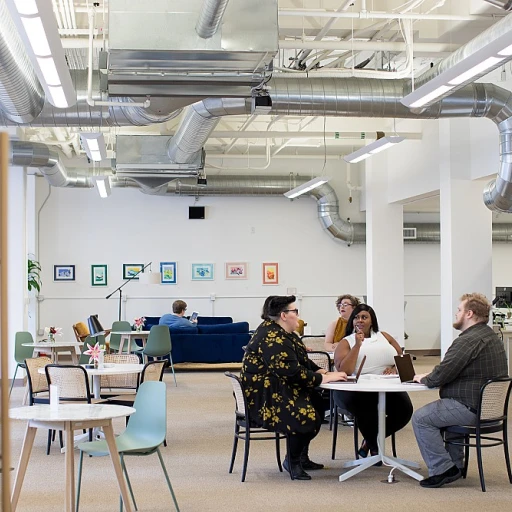
Understanding the Minimum Viable Product
Unraveling the Essence of MVP
In the realm of product development, the concept of a Minimum Viable Product (MVP) serves as a cornerstone for agile methodologies and lean startups. An MVP is not merely a stripped-down version of a product; it embodies the essential features that address user needs and validate market potential.
The goal of an MVP is to provide early users with a practical solution that is sufficiently functional to gather valuable user feedback. This feedback is crucial as it guides the subsequent development process, helping the team to iterate and refine the product in alignment with the evolving demands of the target audience.
Defining What "Minimum" Means
Determining what constitutes the "minimum" in a minimum viable product involves a deep understanding of the core user requirements and pain points. This understanding is derived from extensive research into the market and customer needs. By maintaining a balance between innovation and practicality, companies can focus on delivering features that truly resonate with users.
Ensuring Viability in Product Development
The "viable" aspect of an MVP emphasizes the necessity for the product to be operational and provide a meaningful user experience. This means the product should be developed to a standard that allows the user to interact with it, thereby enabling the team to gather feedback and make informed decisions for successive iterations. The focus should be on achieving a level of quality that assures the product's value proposition is clearly communicated.
For those looking into crafting AI-powered applications within their MVP, it's important to integrate such technologies wisely, ensuring they enhance the product's usability and engage customers effectively.
Building a Foundation for Continuous Improvement
The MVP's true value is realized through iteration. By continuously testing, adapting, and refining the product based on user interactions, the development process becomes agile and responsive. Each iteration brings the product closer to achieving its maximum market potential and enhances its ability to meet future needs, preparing it for rapid changes in the future of work landscape.
The Role of Iteration in MVP Development
Integrating Iterations for Continuous Improvement
Developing a Minimum Viable Product (MVP) isn't just about launching the simplest version of your product; it's an ongoing process of analyzing, adjusting, and enhancing. The role of iteration in MVP development is crucial, providing the flexibility necessary to adapt to user needs and market demands. By incorporating regular iterations, companies can steadily evolve their product towards an optimal solution that meets their user base's expectations. Iterations allow for continuous user feedback, an invaluable component in understanding pain points and refining product features. Each feedback cycle offers insights into how users interact with your product, highlighting areas that require enhancement or pose usability challenges. With this feedback, a product team can make informed decisions about the minimum features necessary to maintain a viable product in the market. Adopting an agile methodology also aids in effective iteration. An agile approach emphasizes adaptability, encouraging teams to implement changes incrementally. This way, they can promptly respond to shifting market dynamics and user requirements without overhauling the entire product development process. Agile frameworks support the project's momentum, minimizing time wasted on features that don't align with user needs or expectations. Regular testing is another key aspect of iteration in MVP development. Testing different aspects of the product with real users ensures that the team is building a version of the product that reflects actual usage patterns and customer preferences. Through iterative testing, the development team can fine-tune the user experience, leading to a product that's not only functional but also delightful to use. Ultimately, iteration bridges the gap between initial product concepts and market-ready solutions. By continuously refining the MVP through user feedback and agile methodologies, businesses can deliver a minimum marketable product that resonates with their target audience. For those keen to explore further how iterations and integrations impact learning and development environments, explore AI integration in educational tech platforms.Adapting to Rapid Changes in the Future of Work
Embracing Flexibility in Product Development
The future of work is characterized by rapid changes and evolving demands, making it crucial for teams to adapt their development process to stay competitive. In this context, the concept of a Minimum Viable Product (MVP) becomes even more significant. It allows teams to quickly build a version of their product that contains the minimum features necessary to meet the needs of early users, gather feedback, and iterate based on real-world input.
Incorporating agile methodologies into MVP development is essential for adapting to these changes. Agile emphasizes flexibility, allowing teams to respond promptly to user feedback and market shifts. This approach not only improves the user experience but also ensures that the product remains relevant and viable in a constantly changing environment.
Iterative Feedback Loops
One of the critical aspects of adapting to rapid changes is establishing iterative feedback loops. By continuously engaging with customers and incorporating their insights, teams can refine their MVP to better address user pain points. This process involves regular testing and gathering feedback, which informs subsequent iterations of the product. As a result, the development team can prioritize features that align with the needs of their target audience, ensuring that the product remains both innovative and practical.
Moreover, leveraging user feedback in the MVP iteration process helps teams identify potential issues early, reducing the time and resources spent on unnecessary features. This lean startup approach not only accelerates product development but also enhances the overall viability of the product in the market.
Adapting to Emerging Technologies
As new technologies emerge, teams must be prepared to integrate these advancements into their MVP development strategies. This might involve adopting new tools for project management, utilizing software development platforms that support agile practices, or exploring innovative ways to enhance the user experience. By staying informed about technological trends, teams can ensure that their MVP remains competitive and aligned with future market demands.
In summary, adapting to rapid changes in the future of work requires a flexible and iterative approach to product development. By embracing agile methodologies, establishing feedback loops, and integrating emerging technologies, teams can create a minimum viable product that meets the evolving needs of their customers and the market.
Balancing Innovation and Practicality
Striking a Balance for Effective Development
Balancing innovation with practicality is crucial in the process of MVP development. An efficient product development team must find equilibrium between creative solutions and the practical needs of users. Developing a minimum viable product is not just about coming up with groundbreaking ideas; it also involves determining which features are essential to address the target audience's pain points. To achieve this balance, an agile approach can be particularly effective. Agile methodologies enable teams to adapt quickly, incorporating user feedback throughout the development process. This iterative method ensures that the version of the product being built is both innovative and aligns with user expectations. One must recognize that while injecting innovation is vital for retaining competitive edge, practicality in terms of usability and customer experience remains a priority. For example, a feature that dazzles in theory might not translate well into user experience if it neglects core user needs. Thus, building an MVP involves continuous iteration to refine the product features based on user insights. Creating an MVP with balanced innovation often requires emphasis on:- Understanding the target market: It’s important to know who the potential customers are, what their needs are, and how the product can solve their specific problems. This requires collecting and analyzing user feedback regularly.
- Prioritizing minimum marketable features: Concentrate on features that deliver value and solve key user pain points without overwhelming the development resources and timeline.
- Iterative testing and feedback: Testing the product with real users allows the team to gather constructive feedback, helping in making informed decisions about subsequent iterations.
Case Studies: Successful MVP Iterations
Real-World Examples of MVP Success
In the dynamic landscape of product development, some companies have excelled by effectively leveraging the iterative process to refine their Minimum Viable Products (MVPs). These case studies highlight how focusing on user feedback and agile methodologies can lead to successful MVP iterations, ultimately resulting in a viable product that resonates with the target audience.
Case Study 1: A Tech Startup's Journey
A tech startup aiming to disrupt the software development industry began with a basic version of their product MVP. Initially, the product offered only the minimum features necessary to address the primary pain points of their target market. By gathering feedback from early users, the team was able to iterate quickly, adapting the product to better meet customer needs. This approach not only saved time but also ensured that the final product was closely aligned with market demands.
Case Study 2: An E-commerce Platform's Evolution
An e-commerce platform focused on improving user experience by building an MVP that allowed customers to test a streamlined version of their service. The development process involved continuous testing and iteration based on user feedback. By prioritizing the most critical features and gradually expanding the product's capabilities, the team was able to create a minimum marketable product that attracted a larger user base.
Case Study 3: Revolutionizing the Health Sector
In the health sector, a company launched an MVP aimed at improving patient engagement through a mobile app. The initial version product focused on essential functionalities like appointment scheduling and basic health tracking. By iterating on user feedback and incorporating agile project management practices, the development team successfully expanded the app's features, making it a viable product that enhanced patient interaction and satisfaction.
These examples underscore the importance of iteration in MVP development. By balancing innovation with practicality, companies can create products that not only meet but exceed user expectations. The iterative phases of MVP development allow for a flexible response to market changes, ensuring that the final product is both innovative and practical.
Future Trends in MVP Development
Embracing the Future of MVP Development
The development of minimum viable products is experiencing a transformative shift, driven by emerging trends and opportunities in the modern market landscape. As organizations continue to adapt to an agile development approach, several key trends are shaping the future of MVP development.- Enhanced User Feedback Integration: Modern MVP development increasingly prioritizes real-time user feedback. This allows teams to continuously refine product features based on user experience and pain points, ensuring that the final product aligns closely with customer needs and expectations.
- Automation and AI: The role of artificial intelligence in the development process is growing. AI tools are becoming crucial in refining iterations, providing data-driven insights, and enhancing project management efficiency. This technological integration allows for quicker viability assessment and accelerates the innovation process.
- Focus on Customer-Centric Design: With an increased emphasis on understanding the target audience, MVPs are developed with a focus on addressing specific customer needs. This involves not only gathering detailed feedback but also assessing market demands to ensure the product is truly marketable.
- Agile and Lean Methodologies: The adoption of agile frameworks and lean startup principles remains vital in MVP iteration. These methodologies support continuous improvement through iterative cycles and facilitate rapid response to market and customer feedback.
- Cross-Functional Teams: More organizations are leveraging cross-functional teams in their MVP development process. This collaboration across different expertise areas fosters innovative ideas and solutions, contributing to more robust product offerings.
- Evolving Testing Environments: Building an MVP now involves sophisticated testing environments that simulate real-world user interactions. These environments help gather insightful feedback and refine the product before full-scale launch, ultimately benefiting user experience.












